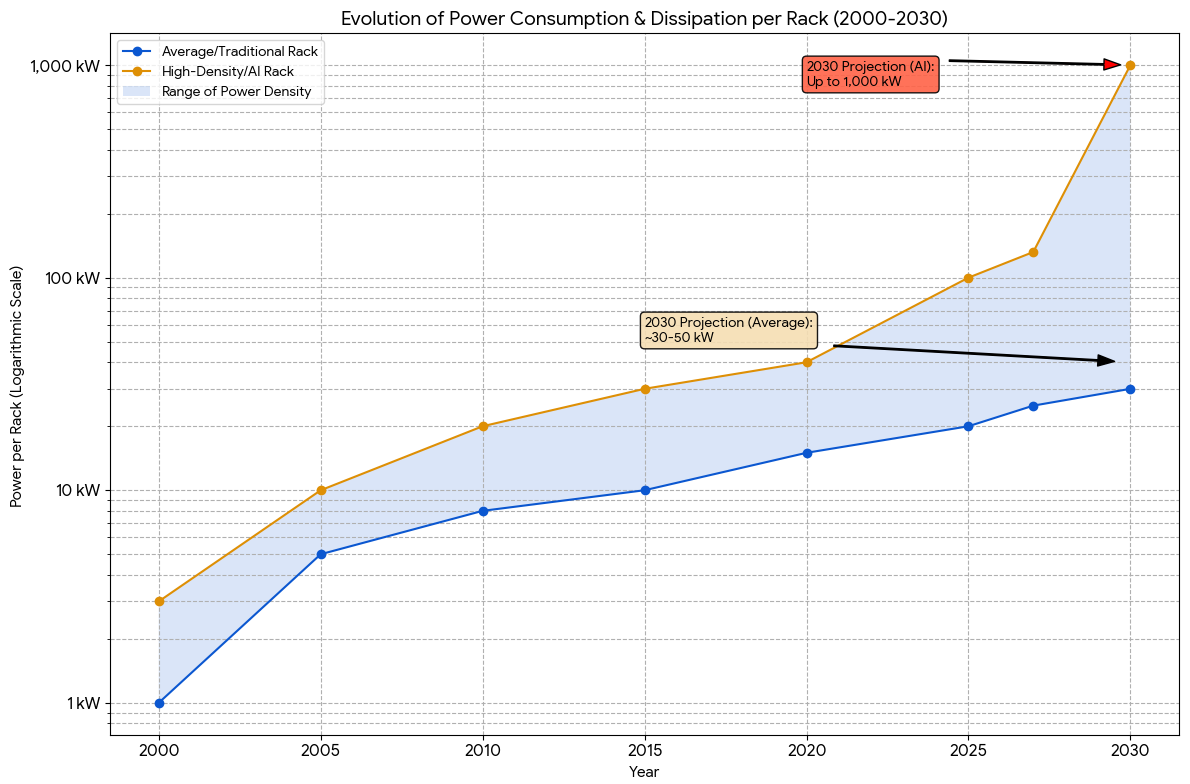This graph alone shows how global AI power consumption is getting out of hand very quickly – and it’s not just about hyperscalers or OpenAI
By Wayne Williams
Copyright techradar

Skip to main content
Tech Radar Pro
Tech Radar Gaming
Close main menu
the business technology experts
België (Nederlands)
Deutschland
North America
US (English)
Australasia
New Zealand
View Profile
Search TechRadar
Expert Insights
Website builders
Web hosting
Best web hosting
Best office chairs
Best website builder
Best antivirus
Expert Insights
Don’t miss these
AI workloads are reshaping infrastructure – here’s what data centers need to know
AI’s infrastructure problem is bigger than we think—here’s how to solve it
How can we create a sustainable AI future?
Many top data center locations could be at risk of climate change
AI’s energy demands are surging – the grid needs to catch up
Is the UK energy grid ready for AI’s power demands?
Global AI usage surge could cause US electricity prices to increase by 18% within years – and that’s just the beginning
Data center infrastructure is the “unsung foundation” of the Government’s ambitious AI agenda
$1 trillion worth of data centers by 2030: US leads the way when it comes to colocation and hyperscale capacity – but for how long?
Remember the doomed AI nation ship? A shipping giant is now planning a real, moving, floating data center that could power thousands of AI GPUs
Google says it will switch off energy-heavy AI usage at critical points if needed
Sam Altman’s vision for AI is huge – but there’s just one thing standing in his way
Not as thirsty as we thought – average data center uses less water than a ‘typical leisure center’, study claims
Meta unveils new plans for multi-gigawatt datacenter clusters the size of Manhattan
AWS is working on proprietary innovative cooling tech to use on Nvidia GPUs for now — I wouldn’t be surprised if Graviton chips get it as well
This graph alone shows how global AI power consumption is getting out of hand very quickly – and it’s not just about hyperscalers or OpenAI
Wayne Williams
27 September 2025
AI racks could consume 20 to 30 times the energy of traditional racks by 2030
When you purchase through links on our site, we may earn an affiliate commission. Here’s how it works.
(Image credit: Lennox Data Center Solutions)
AI-focused racks are projected to consume up to 1MW each by 2030
Average racks expected to rise steadily to 30-50kW within the same period
Cooling and power distribution becoming strategic priorities for future data centers
Long considered the basic unit of a data center, the rack is being reshaped by the rise of AI, and a new graph (above) from Lennox Data Centre Solutions shows how quickly this change is unfolding.
Where they once consumed only a few kilowatts, projections from the firm suggest by 2030 an AI-focused rack could reach 1MW of power use, a scale that was once reserved for entire facilities.
Average data center racks are expected to reach 30-50kW in the same period, reflecting a steady climb in compute density, and the contrast with AI workloads is striking.
You may like
AI workloads are reshaping infrastructure – here’s what data centers need to know
AI’s infrastructure problem is bigger than we think—here’s how to solve it
How can we create a sustainable AI future?
New demands for power delivery and cooling
According to projections, a single AI rack can use 20 to 30 times the energy of its general-purpose counterpart, creating new demands for power delivery and cooling infrastructure.
Ted Pulfer, director at Lennox Data Centre Solutions, said cooling has become central to the industry.
“Cooling, once ‘part of’ the supporting infrastructure, has now moved to the forefront of the conversation, driven by increasing compute densities, AI workloads and growing interest in approaches such as liquid cooling,” he said.
Pulfer described the level of industry collaboration now taking place. “Manufacturers, engineers and end users are all working more closely than ever, sharing insights and experimenting together both in the lab and in real-world deployments. This hands-on cooperation is helping to tackle some of the most complex cooling challenges we’ve faced,” he said.
Are you a pro? Subscribe to our newsletter
Sign up to the TechRadar Pro newsletter to get all the top news, opinion, features and guidance your business needs to succeed!
Contact me with news and offers from other Future brandsReceive email from us on behalf of our trusted partners or sponsorsBy submitting your information you agree to the Terms & Conditions and Privacy Policy and are aged 16 or over.
The aim of delivering 1MW of power to a rack is also reshaping how systems are built.
“Instead of traditional lower-voltage AC, the industry is moving towards high-voltage DC, such as +/-400V. This reduces power loss and cable size,” Pulfer explained.
“Cooling is handled by facility ‘central’ CDUs which manage the liquid flow to rack manifolds. From there, the fluid is delivered to individual cold plates mounted directly on the servers’ hottest components.”
You may like
AI workloads are reshaping infrastructure – here’s what data centers need to know
AI’s infrastructure problem is bigger than we think—here’s how to solve it
How can we create a sustainable AI future?
Most data centers today rely on cold plates, but the approach has limits. Microsoft has been testing microfluidics, where tiny grooves are etched into the back of the chip itself, allowing coolant to flow directly across the silicon.
In early trials, this removed heat up to three times more effectively than cold plates, depending on workload, and reduced GPU temperature rise by 65%.
By combining this design with AI that maps hotspots across the chip, Microsoft was able to direct coolant with greater precision.
Although hyperscalers could dominate this space, Pulfer believes that smaller operators still have room to compete.
“At times, the volume of orders moving through factories can create delivery bottlenecks, which opens the door for others to step in and add value. In this fast-paced market, agility and innovation continue to be key strengths across the industry,” he said.
What is clear is that power and heat rejection are now central issues, no longer secondary to compute performance.
As Pulfer puts it, “Heat rejection is essential to keeping the world’s digital foundations running smoothly, reliably and sustainably.”
By the end of the decade, the shape and scale of the rack itself may determine the future of digital infrastructure.
You might also like
Cooling high-density data centers with coolant distribution units
New fanless cooling technology enhances energy efficiency for AI workloads
Liquid cooling gains momentum as AI workloads turn up the heat in data centers
Wayne Williams
Social Links Navigation
Wayne Williams is a freelancer writing news for TechRadar Pro. He has been writing about computers, technology, and the web for 30 years. In that time he wrote for most of the UK’s PC magazines, and launched, edited and published a number of them too.
You must confirm your public display name before commenting
Please logout and then login again, you will then be prompted to enter your display name.
AI workloads are reshaping infrastructure – here’s what data centers need to know
AI’s infrastructure problem is bigger than we think—here’s how to solve it
How can we create a sustainable AI future?
Many top data center locations could be at risk of climate change
AI’s energy demands are surging – the grid needs to catch up
Is the UK energy grid ready for AI’s power demands?
Latest in Pro
Watch out – hackers are using AI to make phishing emails even more convincing
Nearly 150,000 patient records exposed in major healthcare data breach – here’s what we know
This devious malware has jumped from Meta over to Google Ads and YouTube to spread – here’s how to stay safe
Microsoft flags dangerous XCSSET macOS malware targeting developers – so be on your guard
I helped create Amazon’s Alexa – here’s why I think businesses should embrace humanity’s analogous imperfection to succeed
US Government tells agencies to patch Cisco firewalls immediately, or face attack
Latest in News
YouTube Music is testing a new feature that sounds a lot like Spotify’s AI DJ
New Samsung Galaxy Z Tri-fold leaks hint at key software and camera zoom features
You can now use Google’s viral Nano Banana AI directly in Photoshop
ICYMI: the week’s 7 biggest tech stories from Apple’s response to ‘Scratchgate’ and the ROG Xbox Ally’s price reveal
Is the DJI Mini 5 Pro really a legal nightmare? Here’s what the world’s big drone regulators told me
Quordle hints and answers for Sunday, September 28 (game #1343)
LATEST ARTICLES
YouTube Music is testing a new feature that sounds a lot like Spotify’s AI DJ
Best Buy launches a surprise 48-hour flash sale ahead of Prime Day – here are the 15 best deals I’d buy
The Sony A7 V could launch soon – here are 5 upgrades that could make it the perfect all-rounder
NYT Connections hints and answers for Sunday, September 28 (game #840)
Quordle hints and answers for Sunday, September 28 (game #1343)
TechRadar is part of Future US Inc, an international media group and leading digital publisher. Visit our corporate site.
Contact Future’s experts
Terms and conditions
Privacy policy
Cookies policy
Advertise with us
Web notifications
Accessibility Statement
Future US, Inc. Full 7th Floor, 130 West 42nd Street,
Please login or signup to comment
Please wait…



